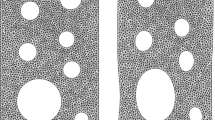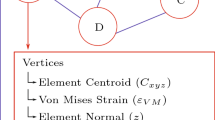Abstract
This paper proposes a data-driven method to predict mechanical responses for structures directly from full-field observations obtained on previously tested structures, with minimal introduction of arbitrary models. The fundamental concept is to directly use raw data, called patches from hereon, comprising displacement fields over large domains, obtained during data harvesting through full-field measurement. These displacement fields have been observed on domains of real structures, and hence are naturally viable solutions from static, kinematic, and constitutive viewpoint. We compile a library of such patches to compute response for new structures. Patches are assembled as pieces of a jigsaw puzzle, similar to how Frankenstein put his monster together from human patches. The approach is illustrated using a traditional beam problem for simplicity. However, the approach is not limited to beam or even solid mechanics, the concept can be applied to predict a wide range of physics and multi-physics phenomena.









Similar content being viewed by others
References
Cauchy AL (1828) Sur les équations qui expriment les conditions d’équilibre, ou les lois du mouvement intérieur d’un corps solide, élastique ou non élastique. Exercices de mathematiques: Troisième Année, Exercices de mathematiques, vol 3. Bure Frères, Paris, pp 160–187
Cauchy AL (1829) Sur l’équilibre et le mouvement intérieur des corps considérés comme des masses continues. Exercices de mathematiques: Quatrième Année, Exercices de mathematiques, vol 4. Bure Frères, Paris, pp 193–319
Silling SA (2000) Reformulation of elasticity theory for discontinuities and long-range forces. J Mech Phys Solids 48(1):175–209. https://doi.org/10.1016/S0022-5096(99)00029-0
Ladevèze P, Chamoin L (2016) The constitutive relation error method: a general verification tool. In: Chamoin L, Díez P (eds) Verifying calculations—forty years on: an overview of classical verification techniques for FEM simulations. Springer, Cham, pp 59–94. https://doi.org/10.1007/978-3-319-20553-3_4
Florentin E, Lubineau GH (2010) Identification of the parameters of an elastic material model using the constitutive equation gap method. Comput Mech 46(4):521–531. https://doi.org/10.1007/s00466-010-0496-y
Mozaffar M, Bostanabad R, Chen W et al (2019) Deep learning predicts path-dependent plasticity. Proc Natl Acad Sci USA 116(52):26414–26420. https://doi.org/10.1073/pnas.1911815116
Stoffel M, Bamer F, Markert B (2019) Neural network based constitutive modeling of nonlinear viscoplastic structural response. Mech Res Commun 95:85–88. https://doi.org/10.1016/j.mechrescom.2019.01.004
Ibañez R, Abisset-Chavanne E, Aguado JV et al (2018) A manifold learning approach to data-driven computational elasticity and inelasticity. Arch Comput Methods Eng 25(1):47–57. https://doi.org/10.1007/s11831-016-9197-9
Kirchdoerfer T, Ortiz M (2016) Data-driven computational mechanics. Comput Methods Appl Mech Eng 304:81–101. https://doi.org/10.1016/j.cma.2016.02.001. arXiv:1510.04232
Kirchdoerfer T, Ortiz M (2017) Data driven computing with noisy material data sets. Comput Methods Appl Mech Eng 326:622–641. https://doi.org/10.1016/j.cma.2017.07.039
Kirchdoerfer T, Ortiz M (2018) Data-driven computing in dynamics. Int J Numer Methods Eng 113(11):1697–1710. https://doi.org/10.1002/nme.5716
He Q, Chen JS (2020) A physics-constrained data-driven approach based on locally convex reconstruction for noisy database. Comput Methods Appl Mech Eng 363(112):791. https://doi.org/10.1016/j.cma.2019.112791
Tang S, Zhang G, Yang H et al (2019) MAP123: a data-driven approach to use 1D data for 3D nonlinear elastic materials modeling. Comput Methods Appl Mech Eng 357(112):587. https://doi.org/10.1016/j.cma.2019.112587
Eggersmann R, Kirchdoerfer T, Reese S et al (2019) Model-free data-driven inelasticity. Comput Methods Appl Mech Eng 350:81–99. https://doi.org/10.1016/j.cma.2019.02.016
Xu R, Yang J, Yan W et al (2020) Data-driven multiscale finite element method: from concurrence to separation. Comput Methods Appl Mech Eng 363(112):893. https://doi.org/10.1016/j.cma.2020.112893
Stainier L, Leygue A, Ortiz M (2019) Model-free data-driven methods in mechanics: material data identification and solvers. Comput Mech 64(2):381–393. https://doi.org/10.1007/s00466-019-01731-1
Leygue A, Coret M, Réthoré J et al (2018) Data-based derivation of material response. Comput Methods Appl Mech Eng 331:184–196. https://doi.org/10.1016/j.cma.2017.11.013
Leygue A, Seghir R, Réthoré J et al (2019) Non-parametric material state field extraction from full field measurements. Comput Mech 64(2):501–509. https://doi.org/10.1007/s00466-019-01725-z
Pijaudier-Cabot G, Bažant ZP (1987) Nonlocal damage theory. J Eng Mech 113(10):1512–1533. https://doi.org/10.1061/(ASCE)0733-9399(1987)113:10(1512)
Bažant ZP (1991) Why continuum damage is nonlocal: micromechanics arguments. J Eng Mech 117(5):1070–1087. https://doi.org/10.1061/(ASCE)0733-9399(1991)117:5(1070)
Bažant ZP, Jirásek M (2002) Nonlocal integral formulations of plasticity and damage: survey of progress. J Eng Mech 128(11):1119–1149. https://doi.org/10.1061/(ASCE)0733-9399(2002)128:11(1119)
Ladevèze P, Lubineau GH, Marsal D (2006) Towards a bridge between the micro- and mesomechanics of delamination for laminated composites. Compos Sci Technol 66(6):698–712. https://doi.org/10.1016/j.compscitech.2004.12.026
Nonis C, Niezrecki C, Yu TY et al (2013) Structural health monitoring of bridges using digital image correlation. In: Smart structures and materials + nondestructive evaluation and health monitoring, 8695 health monitoring of structural and biological systems, vol 869507. SPIE, San Diego (CA). https://doi.org/10.1117/12.2009647
Stinville J, Echlin M, Texier D et al (2016) Sub-grain scale digital image correlation by electron microscopy for polycrystalline materials during elastic and plastic deformation. Exp Mech 56(2):197–216. https://doi.org/10.1007/s11340-015-0083-4
Moussawi A, Lubineau G, Florentin E et al (2013) The constitutive compatibility method for identification of material parameters based on full-field measurements. Comput Methods Appl Mech Eng 265:1–14. https://doi.org/10.1016/j.cma.2013.06.003
Silling SA, Epton M, Weckner O et al (2007) Peridynamic states and constitutive modeling. J Elast 88(2):151–184. https://doi.org/10.1007/s10659-007-9125-1
Wang L, Wang J (2019) On the invariance of governing equations of current nonlocal theories of elasticity under coordinate transformation and displacement gauge change. J Elast 137(2):237–246. https://doi.org/10.1007/s10659-018-09715-7
Jirásek M (2020) Nonlocal theories. In: Encyclopedia of continuum mechanics. Springer, Berlin, pp 1869–1892. https://doi.org/10.1007/978-3-662-55771-6_148
Sutton MA, Orteu JJ, Schreier HW (2009) Image correlation for shape, motion and deformation measurements: basic concepts, theory and applications, 1st edn. Springer, New York
Acknowledgements
The authors acknowledge financial support received from King Abdullah University of Science and Technology (grant BAS/1/1315-01-01).
Author information
Authors and Affiliations
Contributions
The research was performed by van der Heijden, who wrote the paper and made the required code. The research was performed under the supervision of Lubineau who defined the research direction and formulated the initial concept. Wang collaborated and created a two-dimensional implementation that was not used for this paper, although some of his concepts have been incorporated into the overall method.
Corresponding author
Ethics declarations
Conflict of interest
The authors declare no conflict of interest.
Additional information
Publisher's Note
Springer Nature remains neutral with regard to jurisdictional claims in published maps and institutional affiliations.
Rights and permissions
Springer Nature or its licensor (e.g. a society or other partner) holds exclusive rights to this article under a publishing agreement with the author(s) or other rightsholder(s); author self-archiving of the accepted manuscript version of this article is solely governed by the terms of such publishing agreement and applicable law.
About this article
Cite this article
van der Heijden, B., Wang, Y. & Lubineau, G. Frankenstein’s data-driven computing approach to model-free mechanics. Comput Mech 71, 1269–1280 (2023). https://doi.org/10.1007/s00466-023-02307-w
Received:
Accepted:
Published:
Issue Date:
DOI: https://doi.org/10.1007/s00466-023-02307-w




